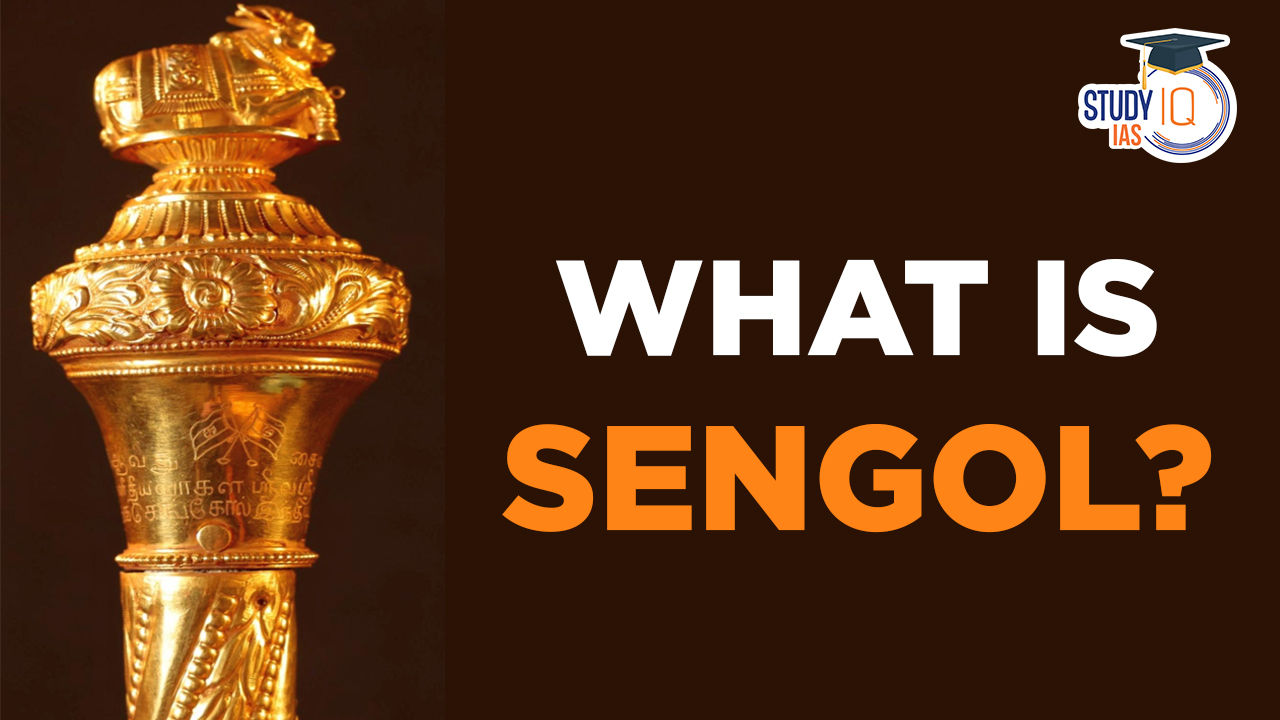Table of Contents
Samajwadi Party MP RK Chaudhary’s Statement on Sengol
Samajwadi Party MP R K Chaudhary has called for the removal of the Sengol from the Lok Sabha, labeling it a symbol of “rajtantra” (monarchy) and suggesting it be replaced with a replica of the Constitution. Chaudhary argued that Parliament should reflect democracy, not monarchy. The Sengol, installed by PM Narendra Modi in May 2023, was originally presented by Lord Mountbatten and placed in a museum by Nehru. The BJP condemned Chaudhary’s demand, calling it an insult to Indian and Tamil culture. Uttar Pradesh CM Yogi Adityanath also criticized the remarks as “disgraceful.”
The installation of a venerable golden sceptre named Sengol near the Lok Sabha Speaker’s seat is now again in controversy. The Sengol represents India’s independence, sovereignty, cultural diversity, and history.
What is Sengol?
In essence, the “Sengol” is a sceptre. One of the longest-reigning dynasties in history, the Chola dynasty of South India, is where Sengol first appeared. Jawaharlal Nehru, the first Prime Minister of Independent India, accepted the “Sengol” as a symbol of the handover of authority from the British. It was then placed in an Allahabad museum.
As a token of just and equitable governance during the Chola dynasty, the sacred “sengol” was used to signify the handover of authority from one monarch to another. The five-foot-tall sceptre, which will be displayed for everyone to see close to the Lok Sabha Speaker’s platform, is topped with a Nandi, or bull. The sceptre is made of silver and is covered with gold. It is currently on display in the Allahabad Museum.
The expectation that the person receiving the sengol will rule in a just and fair manner is what matters most. On August 14, the “sacred sengol ceremony” was held shortly prior to Pandit Nehru’s well-known midnight “Tryst of Destiny” speech. It is a representation of the need for just, policy-compliant, and morally righteous governance. This will convey a message to the general public and elected officials.
History of Sengol
The Sengol, which is derived from the Tamil word “Semmai” and means “Righteousness,” has a profound connotation. It was constructed out of gold or silver and frequently adorned with priceless stones.
| Details about Sengol | |
| Symbolism |
|
| Chola Empire |
|
| Territorial Reach |
|
| Achievements of the Cholas |
|
| Ceremonial Use |
|
Sengol and Tamil Tradition
The last British viceroy, Lord Mountbatten, intended to commemorate the historic occasion when the British ceremonially handed over authority to the Indians. He approached Jawaharlal Nehru, who apparently sought advice from C Rajagopalachari, a fellow member of the Indian National Congress, regarding the situation.
Rajagopalachari developed the concept of the sceptre that was employed in Tamil tradition after doing some research. A high priest presents a sceptre to the new king when he takes over the throne. He is reported to have told Nehru that this is the tradition followed by the Cholas and that it might be utilised to commemorate India’s independence from the British Raj.
Rajagopalachari approached Thiruvaduthurai Atheenam, a significant religious organisation in contemporary Tamil Nadu, with the task of having a sceptre made. Vummidi Bangaru was given the task by the mutt’s spiritual leader at the time, and with his assistance, the sceptre’s design and acquisition were completed.
Significance of Sengol
Sengol is regarded as a representation of justice, the handover of power, and sound government. On August 14, 1947, it was given to Jawaharlal Nehru, the nation of India’s first prime minister. This event served as the official handover of authority from the British Government to India. After more than 75 years, the very same Sengol will once again represent the transition of power on May 28.
The sceptre serves as a symbol of India’s illustrious past and vibrant culture. Its ancestors were members of the Chola dynasty, one of India’s most significant and powerful empires. “Even after 75 years of independence, most Indians are unaware of this event, in which India’s transfer of power took place through the handing over of Sengol to Pt. Jawaharlal Nehru,” claims Home Minister Amit Shah.
The sceptre serves as a symbol of India’s illustrious past and vibrant culture. Its ancestors were members of the Chola dynasty, one of India’s most significant and powerful empires. “Even after 75 years of independence, most Indians are unaware of this event, in which India’s transfer of power took place through the handing over of Sengol to Pt. Jawaharlal Nehru,” claims Home Minister Amit Shah.”
Sengol in New Parliament Building
Nehru kept the Sengol sceptre at his home in Delhi for a while after receiving it in 1947. Then he made the choice to give it to his ancestral home’s Anand Bhavan Museum in Allahabad (now Prayagraj). His father Motilal Nehru founded the museum in 1930 to preserve the background and legacies of the Indian independence movement.
For more than seven decades, the Sengol sceptre was housed at the Anand Bhavan Museum. The government made the decision to resurrect this historic occasion and place the Sengol sceptre in the new Parliament building in 2021–2022 when the Central Vista reconstruction project was underway. It will be situated next to the Speaker’s seat in the New Parliament Building and a plaque explaining its background and significance will be erected alongside it.
Sengol’s placement in the new Parliament building sends a profound message in addition to serving as a symbolic act. It shows that India’s democracy is inclusive, respects diversity, and is based on the country’s long-standing traditions and ideals.
Sengol UPSC
Jawaharlal Nehru, the first Prime Minister of Independent India, accepted the “Sengol” as a symbol of the handover of authority from the British. It was then placed in an Allahabad museum. As a token of just and equitable governance and during the Chola Dynasty, the sacred “sengol” was used to signify the handover of authority from one monarch to another.
The five-foot-tall sceptre, which will be displayed for everyone to see close to the Lok Sabha Speaker’s platform, is topped with a Nandi, or bull.


 Indian Council for Agricultural Research...
Indian Council for Agricultural Research...
 World Day for International Justice 2025...
World Day for International Justice 2025...
 Anusandhan National Research Foundation ...
Anusandhan National Research Foundation ...





















